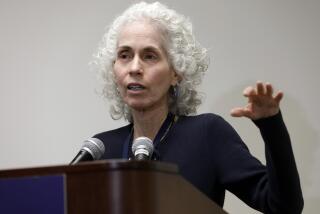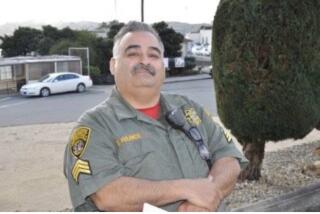‘This Is Someone’s Life Here’
- Share via
Relatives of two people who contracted Legionnaires’ disease and died at Good Samaritan Hospital since May said doctors at the downtown Los Angeles facility did not inform them of the patients’ hospital-acquired respiratory infections.
At least, that was the case until Tuesday, when the children of one of the patients were telephoned by the hospital’s chief of staff, told of the infection and warned to expect a call from a reporter about the case. The patient, Kwok Hin Cheng, 65, died on June 15.
For the record:
12:00 a.m. July 11, 2002 For The Record
Los Angeles Times Thursday July 11, 2002 Home Edition Main News Part A Page 2 National Desk 21 inches; 763 words Type of Material: Correction
Legionnaires’ disease--In some editions of the July 3 California section, a photo caption incorrectly reported that Charles Griego died of Legionnaires’ disease at Good Samaritan Hospital in Los Angeles. Griego contracted the disease at the hospital, but doctors there say he did not die of it. His death certificate lists the primary cause of death as a heart ailment. In other editions, a photo caption incorrectly implied that Griego’s children had just learned that their father died after heart surgery. In fact, they had just learned of their father’s infection with hospital- acquired Legionnaires’ disease.
*
“They should have informed us about it,” said Anderson Cheng, 25, the man’s son. “Of course, they’re trying to cover themselves now. This is someone’s life here.”
Death certificates for the two patients, prepared by Good Samaritan physicians, do not list Legionnaires’ disease as the cause of death or as a significant contributing condition, although one certificate mentions pneumonia, which can be caused by the Legionella pneumophila bacteria.
The hospital previously had said that it was uncertain what role Legionnaires’ may have played in the deaths. In a written statement Tuesday, Good Samaritan said no patients had died as a result of hospital-acquired Legionnaires’ disease, even though lab tests showed the presence of L. pneumophila in the two patients who died.
“We take our obligation seriously to keep patients and family members informed of their medical condition,” the statement said. “In the case of death, the next of kin is always informed of our current understanding of the cause of death.”
Seven other patients became ill with Legionnaires’ disease at good Samaritan, beginning in January, but all are recovering or have recovered after being given antibiotics. A person contracts the infection by breathing mist that comes from a water source contaminated with the L. pneumophila bacteria. Not all people exposed become infected.
Until Tuesday, Cheng’s family believed that his heart “just gave out,” his son said. Cheng, a chef who immigrated to the United States from Hong Kong in 1969, had recently taken his citizenship test. Notice that he was to be sworn in as an American citizen arrived by mail on the day of his funeral.
“We were expecting my dad to come home,” Anderson Cheng said. “Everything was fine after his bypass. They told us everything was fine. His heart was beating regularly.”
Several days before Cheng died, and about a week after his bypass surgery, he was taken from his regular room to the intensive care unit because of a buildup of fluid in his chest.
On his death certificate, doctors listed Cheng’s problems as cardiopulmonary arrest, a lack of oxygen flowing to the tissues of the heart, coronary artery disease and diabetes.
The case of 67-year-old Charles Griego was similar, family members said. Phillip Griego, a human resources manager for UPS, said doctors told his family that his father had a “touch of pneumonia” and that he had been given medication, but they weren’t any more specific.
Charles Griego seemed to be recovering from his heart bypass surgery on May 3 at Good Samaritan, his son said. He was sitting up in a chair, eating gelatin or ice cream, and cracking jokes with family members.
But within a week, Griego developed a high fever, loss of appetite and had difficulty breathing--all symptoms of Legionnaires’ disease. He died May 12.
Phillip Griego said he is disappointed that doctors never mentioned that his father had contracted Legionnaires’ disease in the hospital.In fact, when he read about the outbreak in The Times this week, he said, “I thought, ‘Oh, I wonder what happened there?’ I never had even heard of it before.”
A Moral Responsibility
Good Samaritan did not have a legal responsibility to tell patients or their families about the outbreak, several medical ethicists said, but they added that it did have a moral one. The same moral responsibility applies, they said, if a doctor makes a mistake during surgery or if a patient contracts a disease through a blood transfusion.
“Anything that is a plausible factor in the death of a patient or the continued prolonged illness of a patient or the worsening of a patient is something the family is entitled to know,” said Michael H. Shapiro, a law professor at USC.
“Sooner or later, the truth is going to come out and, if there’s a cover-up, it’s going to look really, really bad. People think they can get away with stuff by stonewalling and denying and not disclosing information.... They are supposed to put their ... patients’ interests above their own.”
If Good Samaritan withheld information from patients about the outbreak, that would be “indefensible,” said bioethicist Gregory Stock.
“You can certainly see what the motivation of the hospital is not to tell,” said Stock, director of the Program on Medicine, Technology and Society at UCLA’s Geffen School of Medicine. “There probably are all sorts of liability issues that are involved there.”
The state gives doctors considerable flexibility in deciding which factors to list on a death certificate. Public health authorities say Good Samaritan officials acted promptly in alerting them to the cases and seeking immediate solutions.
The hospital said patients and their families are told about communicable diseases if the information is “medically significant” and if the disease can be transmitted from person to person, which is not the case for Legionnaires’.
Los Angeles County health officials have already acknowledged that they should have been more forthcoming with the public about the Legionnaires’ outbreak at Good Samaritan. The county knew about the problem as early as March but did not disclose it publicly until Sunday when asked by a Times reporter.
Responsibility rests with physicians, not the county, to notify patients that they have contracted Legionnaires’ disease, said John Wallace, spokesman for the county Department of Health Services.
Good Samaritan says it has taken steps to contain the outbreak--decontaminating its water system, replacing shower heads and giving patients bottled water instead of tap water. The public has never been at risk because Legionnaires’ is not contagious.
Nationally, Legionnaires’ disease affects 8,000 to 18,000 people annually. Most cases are acquired in the home or community, not in health-care facilities. The disease is fatal in 5% to 30% of cases, according to the federal Centers for Disease Control and Prevention.
Griego’s widow, Lilly, said she has many questions for doctors and hospital officials about the death of her husband of 52 years.
“I would really like to look into it further to find out what really happened, to find out what my husband really did die of,” she said. “He came out of the heart surgery great. Even the doctor said, ‘Your husband is doing fine. He did good in surgery.’ ... A couple days later, he started going downhill, everything started going wrong.”
More to Read
Sign up for Essential California
The most important California stories and recommendations in your inbox every morning.
You may occasionally receive promotional content from the Los Angeles Times.













